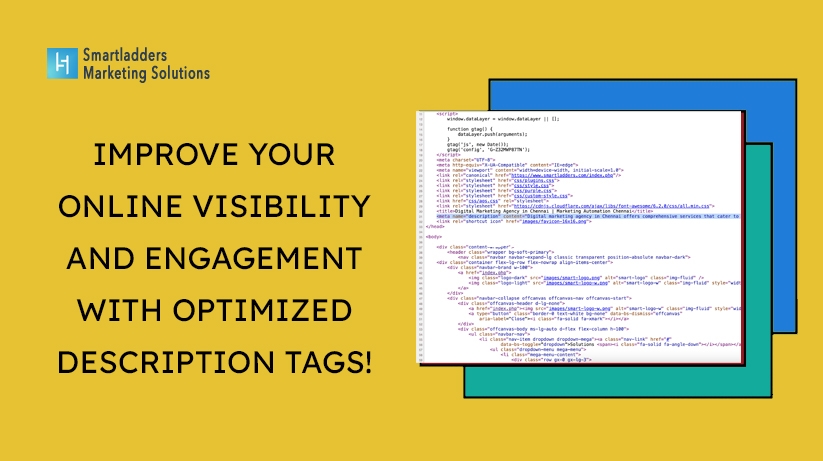
Optimising Your Online Presence: The Importance of Description Tags for Personalised Search, Featured Snippets and Social Media Engagement

Introduction:
Optimising your online presence is crucial in today's digital landscape. One of the key ways to improve your visibility is by utilising description tags effectively. This blog will discuss the importance of description tags for personalised searches, featured snippets, and social media engagement. You can increase your reach across various platforms by understanding how to optimise your description tags.
The Future of Personalised Search: How Description Tags Will Need to Adapt to a World of Individualized Search Results
Understanding the Role of Description Tags in Featured Snippets: How to Optimise Your Description Tags for Google's Answer Boxes and Other Featured Snippets
The Role of Description Tags in Social Media and Other Non-Search Engine Platforms: How to Optimise Your Preview Text for Better Engagement and Click-Through Rates
The Future of Description Tags and SEO: How Search Engines Are Evolving and What You Need to Know
Description tags have been an essential element of SEO for years. They summarise the content on the web page and help search engines get an idea o what the page is all about. As search engines develop, so will the importance and use of description tags. In this blog, we'll explore how search engines evolve and what you need to know to stay ahead of the curve regarding description tags and SEO.
Semantic Search
One of the most significant changes in search engines in recent years has been the shift to semantic search. Semantic search aims to understand meaning and context. Search engines are now looking for more context around a keyword rather than just exact matches. As a result, the importance of well-written and descriptive description tags has increased, providing additional context around the searched keyword.
Machine Learning and AI
Search engines increasingly use machine learning and AI to improve their search algorithms. Machine learning enables search engines to learn from user behaviour and improve the quality of their search results over time. These days search engines are better at understanding user intent, and the importance of description tags will only grow with advancement in this field.
Voice Search
Voice assistants like Siri and Alexa have revolutionised SEO efforts. Voice search is becoming a popular way for people to search for information. It has significant implications for description tags, as people speak in different ways than they type. We should optimise the description tags for conversational search queries, which may be longer and more natural-sounding than typed queries.
Visual Search
Visual search is another trend that is rapidly gaining popularity. You can upload an image and receive search results based on the image's content. Search engines must rely less on text-based information and more on visual elements like images and videos. As a result, using descriptive alt tags for photos and videos will become increasingly important for SEO.
The Future of Description Tags
In light of these trends, it's clear that description tags will continue to be a critical element of SEO in the future. One way to stay ahead of the curve in digital marketing is to ensure that your description tags are descriptive, concise, and accurately reflect the content on your webpage. Optimising your description tags for conversational queries, visual searches, and the intent behind a search query will become increasingly important as search engines evolve.
Understanding the Role of Description Tags in Featured Snippets: How to Optimise Your Description Tags for Google's Answer Boxes and Other Featured Snippets
In today's digital age, optimising your website for search engines has become a crucial aspect of digital marketing. One of the critical strategies to improve your search engine rankings is to aim to appear in featured snippets or answer boxes. To optimise your page for capturing featured snippets, you need to understand the role of description tags and how to optimise them effectively.
What are Description Tags?
Description tags, or meta descriptions, are HTML elements that visually summarize a web page's content. Description tags are essential in attracting users to click on your page and also give them an idea of what type of content exists within the page.
The Role of Description Tags in Featured Snippets
Google's algorithm uses several factors to determine which web pages are suitable for featured snippets. One critical factor is the page content's relevance to the user's query. The content in featured snippets must be concise and to the point, answering the user's question accurately, so we use description tags. While they do not directly influence the featured snippet selection process, you can still optimise your description tags. Your description tag will become the featured snippet if it provides a clear and concise content summary.
How to Optimise Your Description Tags for Featured Snippets?
Now that you understand the importance of description tags in featured snippets, let's explore how you can optimise them for the best results.
Use Relevant Keywords: Use relevant keywords in your description tags to improve their relevance to the user's query. Include the primary keyword phrase in your description tag and keep it concise, clear, and to the point.
Answer the User's Question: Your description tag should answer the user's question accurately and concisely. Ensure that your description tag provides a clear and concise summary of your page's content and is relevant to the user's query.
Keep it Short: It is ideal to have short and sweet description tags. Google's length checker is around 160 characters of your description tag in the SERPs, so keeping your description tag within this limit is essential.
Use Action-Oriented Language: Using action-oriented language in your description tag can increase your page's click-through rate (CTR). Use language that encourages users to take action, such as "Discover," "Learn," or "Find out more."
Don't Duplicate Description Tags: Every webpage should have a unique title or a description tag that accurately describes the page's content. Using multiple descriptive tags can confuse search engines and harm your rankings.
Description tags are essential in optimizing content for search engines, but did you know they also play a crucial role in social media and other non-search engine platforms? In this blog, we'll explore the part of description tags in social media and other platforms and provide tips on optimizing your preview text for better engagement and click-through rates.
What are Description Tags?
Description tags, also known as meta descriptions, are HTML elements that provide a summary of a webpage's content. It appears in the web page's page title and URL section, and the purpose is to give the users a preview of what they can expect to find on the page.
The Role of Description Tags in Search Engine Optimisation
In search engine optimisation (SEO), description tags attract users to click on a particular result. When creating a description tag, you want to provide a short and compelling summary of the page's content, including relevant keywords.
In addition to attracting clicks, a well-crafted description tag can also improve your website's search engine rankings. Search engines use description tags to determine the relevance and quality of a page's content. If the description tag accurately reflects the page's content and includes relevant keywords, it can be great for Google and your visitors.
The Role of Description Tags in Social Media and Other Platforms
Description tags are not limited to search engines; they also play a crucial role in social media and other non-search engine platforms. The description tag appears on social media as the preview text when someone shares a link to your page. The text appears below the title and image and summarizes the content.
Similarly, preview text is also an essential element on other non-search engine platforms like messaging apps or email newsletters. It's the first thing people see, and it can determine whether they decide to click on the link.
Optimising Your Preview Text for Better Engagement and Click-Through Rates. To maximize your preview text for social media and other non-search engine platforms, follow these tips:
Keep it Short and Sweet: Preview text is limited in length, so keep it concise and to the point. Aiming for around 150 characters or less is a good rule of thumb.
Include Relevant Keywords: Like in SEO, including relevant keywords in your preview text can help improve your visibility and attract clicks. Use appropriate and descriptive keywords that accurately reflect the content on your page
Use Action-Oriented Language: Using action-oriented language in your preview text can encourage people to click through to your page. Use phrases like "Learn more" or "Find out how" to entice people to click on your link.
Make it Compelling: Your preview text should be compelling and engaging. Use descriptive language that makes people want to click through to your page. Use numbers, statistics, or other interesting facts to pique interest.
Conclusion
The future of SEO is constantly evolving, and it becomes essential to keep pace with the latest trends and changes. The importance of descriptive and well-written description tags will only grow as search engines become. By optimizing your description tags for semantic search, machine learning and AI, voice search, and visual search, your website is well-positioned for success in the future of SEO. Optimizing your description tags is essential to any SEO strategy, particularly if you want to appear in featured snippets or answer boxes. By following these practices, we can assure you that your description tags accurately summarize your page's content and answer the user's question, boosting your chances of featuring in the snippet box. The description tags are essential in optimizing content for search engines, but they also play a critical role in social media and other non-search engine platforms. By optimizing your preview text for these platforms, you can improve your engagement and click-through rates, driving more traffic to your website.
Search Engine Optimization
06 Nov 2023 | RachelRelated Post
The Ideal Content Length for SEO and Engagement
14 Nov 2023Latest Post







